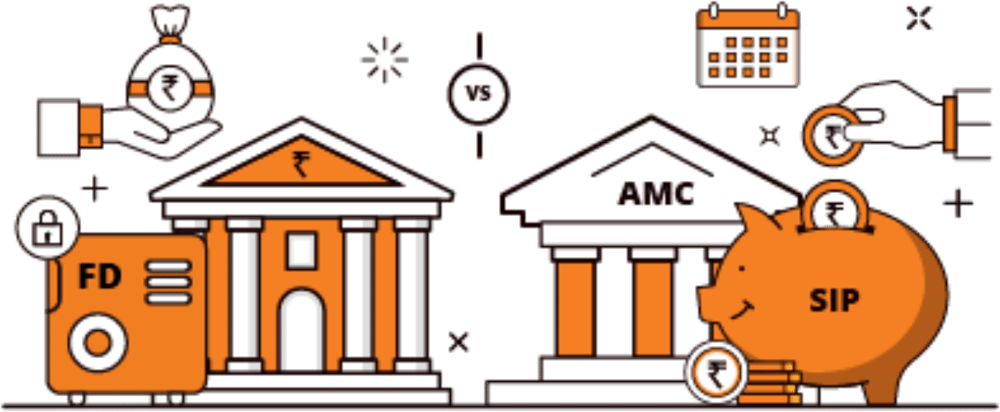In 2025, choosing between SIP (Systematic Investment Plan) and FD (Fixed Deposit) depends on your financial goals. FDs offer guaranteed returns (6.5–7.5%) with low risk, ideal for short-term savings and risk-averse investors. SIPs, on the other hand, provide higher potential returns (10–15%) through mutual funds but come with market-linked risk—perfect for long-term wealth creation.
SIP vs FD in 2025: Best Investment Choice for Your Savings
Written by Kashish Rajput

Alright, let’s cut through the financial jargon and get real about this: in India, talking money is basically a “FD vs SIP” showdown. FDs—Fixed Deposits—are like that favorite old sweater everyone’s aunt swears by. Safe, reliable, zero drama. SIPs—Systematic Investment Plans—on the other hand, are more “new-gen hustle,” the kind of thing your cousin who’s into crypto and fitness bands is always raving about.
Now, it’s 2025. Stuff’s changing, no kidding. FD rates got a bit of a glow-up, which is nice, but mutual fund SIPs? Still the cool kids at the return party. So what’s it gonna be: “safety first” or “show me the money”? Maybe you want both. Greedy? Nope, just smart.
Let’s not waste more time. Here’s the real talk:
🏦 Fixed Deposit (FD)—aka, the OG Saver’s Move
Think of FDs as the good old “lock up your cash, earn some interest, sleep easy” option. You park a lump sum, pick your tenure, and the bank promises you a fixed rate. No surprises, no drama.
What’s Good:
- Interest is fixed. No heart attacks watching the market crash.
- Your money’s safe—banks guarantee it up to ₹5 lakh (thank you DICGC).
- Anyone can get one—banks, post offices, even digital apps.
2025 FD Rates?
- Regular: 6.5% - 7.5%
- Seniors: 7.75% - 8%
Example? Drop ₹1 lakh in for 5 years at 7.5% and you pocket ₹44,000 in interest. Not bad, right?
FDs: Pros & Cons
👍 Pros:
- Rock solid safety. Predictable. Your grandma would approve.
- Super easy to open.
- No market rollercoaster.
👎 Cons:
- Inflation might laugh at your returns.
- Want out early? Penalties, bro.
- Interest is totally taxable. Yeah, the taxman never sleeps.
📈 SIP (Systematic Investment Plan)—The “Let’s Grow Rich” Route
SIPs are like planting a money tree, one seed (rupee) at a time. You invest a bit, regularly, into mutual funds—mostly equity or hybrid. Over time, it adds up. Magic of compounding and all that.
Why People Love SIPs:
- Makes you disciplined, even if you’re usually a financial mess.
- Start as low as ₹100/month. Seriously, one pizza less a month.
- Perfect for long-haul stuff: house, kids’ college, that Bali trip.
2025 Returns?
- Equity mutual funds: 10%–15% (on average, fingers crossed)
- Debt funds: 6%–8%
- ELSS (tax-saving): 12%+ if you can lock it for 3 years
Example: ₹5,000/month for 10 years at 12% gets you ₹11.6 lakh. Invested just ₹6 lakh. That’s like your money hitting the gym and coming out buff.
SIPs: Pros & Cons
👍 Pros:
- Potential for way higher returns.
- Flexibility—start, stop, pause, whatever.
- Tax perks if you hold tight.
- Proper wealth-building machine.
👎 Cons:
- Totally market-linked. Volatility? Oh yeah.
- Needs patience. No overnight millionaires here.
- No guarantees. You gotta trust the process.
FD or SIP? The Million-Rupee Question
Pick FDs if:
- You can’t stand the idea of losing money.
- You’re saving for something soon—like a new phone or a trip.
- You want fixed income (retirees, this is your jam).
- Markets confuse or bore you.
Pick SIPs if:
- You’re in for the long game (think: retirement, house, kids’ future).
- You can handle a few bumps on the ride.
- You want to outpace inflation and taxes.
- You dream big.
🧠 Pro Tip: Mix It Up, Don’t Pick Sides
Why choose? Split your cash. Keep your safety net (emergency fund, short-term splurges) in FDs. Let your dreams ride SIPs for 5, 10, even 20 years. Check in every year or so—see if your plan still fits your life.
Taxes?
Ugh, Here’s the Deal:
- FD interest: Fully taxable. No hiding.
- SIPs:
- Equity funds held over a year? 10% tax after ₹1 lakh profit.
- Debt funds/short-term gains: tax slab applies.
- ELSS: Tax-saving, up to ₹1.5 lakh under 80C.
So, What’s the Move for 2025?
No magic bullet. FDs = peace of mind, slow and steady. SIPs = higher risk, but way better odds at real wealth. Honestly, why not have both? Build a portfolio that lets you sleep at night but keeps your money hustling during the day.
Bottom line: Don’t just let your cash chill—make it work. You work hard for your money. Time for your money to return the favor.